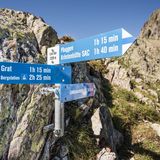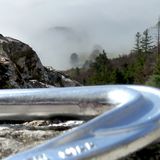
© Alexandra Rozkosny
Safety when climbing Ten tips
Climbing outside offers great opportunities to discover nature, share experiences, take on responsibilities and enjoy adventures. The following advice will help you to deal with any dangers you may have to face when climbing or learning how to climb.
These ten points are based on the recommendations made by the CAA and have been completed by the SAC training and safety experts. However, they can’t replace training courses, which provide a solid base and help you expand your competences and improve your technique with qualified instructors.
Ten tips
1. Fit and healthy
Climbing is an endurance sport. The effort it demands for the heart, circulation, muscles and articulations requires you to be in good health and able to assess your abilities. Avoid being pushed by time and adopt a pace suitable for all members of the group.
2. Careful planning
Information about distance, height differences, the level of difficulty and the conditions can be found on maps, in guide books, online or by asking experts. The weather forecast is particularly important as storms, snow, wind and cold weather can greatly increase the risk of accidents. Make sure that the itinerary is adapted to the level of the group and always plan alternative ones. Take note of the emergency mountain rescue phone numbers of the country (REGA: 1414; European emergency number: 112).
3. Appropriate equipment
Make sure that you have the right equipment and that your rucksack is not too heavy. A rope and a helmet will protect you from slipping and from rockfalls and good shoes will help give you a better grip. Don’t forget sun cream. Make sure that you take a first aid kit, a survival blanket, a mobile phone and a head lamp with you – you’ll be happy to have them on you in case of an emergency.
4. Check the conditions
Receding glaciers, melting snow and the rising limit of the freezing level increase the risk of rockfalls. You should set off early enough, keep checking the current weather and conditions and adapt your itinerary accordingly.
5. Check your partner’s equipment before starting
Always check each other’s equipment thoroughly. Check the knot, the rope, the carabiner, the belay device (check that it works properly), the harness and the belay loop. If you are learning how to climb, make sure there is a knot at the end of the rope.
6. Pay attention when belaying
When you belay your partner, take note of the following points; don’t leave any slack, stay close to the wall (especially when learning), observe your partner, always keep one hand on the rope and under the belay device and communicate clearly.
7. Attach the carabiners to the bolts
The bolts are your life insurance, so it is essential to use them properly. Attach the carabiners in a stable position and make sure you don’t fall while doing so. Make sure that the quickdraws are correctly attached. The rope must not be over any part of the body.
8. Top rope with proper anchors
Climbing schools often have different belays. The following rules must always be respected: no top roping with only one carabiner; on overhanging rocks, make sure you clip the bolts. Check that the rope has been put correctly into the belay device.
9. Check the anchors
On climbing courses, there are many different types of belay. Join the different bolts, complete the ones which don’t appear to be viable with mobile anchors and don’t belay yourself or your partner on the chains.
10. Respect nature
High mountains are a precious area for discovering the uniqueness of nature. Appreciate this freedom and respect the fragile environment. Obey any restrictions, take your rubbish away with you and make sure you are respectful towards other climbers.

